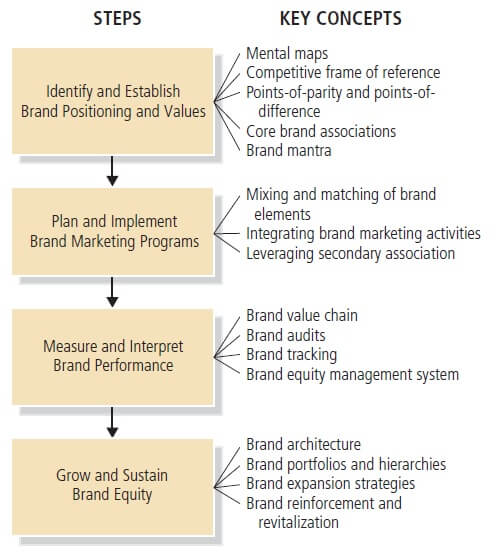The strategic brand management process involves the design and implementation of marketing programs and activities to build, measure, and message brand equity.
Developing a strategy that successfully sustains or improves brand awareness, strengthens brand associations, emphasizes brand quality and utilization, is a part of brand management.
Table of Content
What is Brand Management?
Brand Management is the function of marketing techniques to a specific product, product line, or brand. It seeks to increase the product’s perceived value to the customer and thereby increase brand franchise and brand equity.
Read: What is Brand Management, Importance, Definition
Strategic Brand Management Process
Strategic brand management process is important for creating and sustaining brand equity. Developing a strategy that successfully sustains or improves brand awareness, strengthens brand associations, emphasizes brand quality and utilization, is a part of brand management.
Strategic Brand Management Process has four main steps:
- Identify and Establish Brand Positioning and Values
- Designing and implementing brand marketing programs
- Measuring and interpreting brand performance
- Growing and sustaining brand equity

Identify and Establish Brand Positioning and Values
The first step of the strategic brand management process starts with a clear and concise understanding of what the brand is to represent and how it should be positioned with respect to competitors.
Brand Positioning is defined as “the act of designing the company’s offer and image so that it occupies a distinct and valued place in the target consumer’s mind.”
Philip Kotler
Brand planning uses the following three interlocking models
- Brand positioning model: describes how to guide integrated marketing to maximize competitive advantages.
- Brand resonance model: describes how to create intense, activity loyalty relationships with customers.
- Brand value chain: means to trace the value creation process for brands, to better understand the financial impact of brand marketing expenditures and investments.
Key Concepts
Mental Map
A mental map is a visual depiction or point-of-view perception of the various associations linked to the brand in the consumer’s mind.
Points of difference
It convinces consumers about the attributes or benefits that consumers strongly associate with a brand and believe that they could not find the same in a competitor’s brand.
Points of parity
A product offering that is largely similar to the offerings of like competitors, leading consumers to believe that brand is “good enough” to be included in the category.
Core Brand Associations
Subset of associations i.e. both benefits and attributes which best characterize the brand.
Brand Mantra
Brand mantra is a short, three to five-word phrase that captures the irrefutable essence or spirit, of the brand positioning. It’s similar to the brand essence or the core brand promise also known as the Brand DNA.
Frame of reference
Identifying the target market and the nature of competition.
Plan and Implement Brand Marketing Programs
Building brand equity requires creating a brand that consumers are acceptable aware of and with which they have favourable, strong and unique brand associations.
Key Concepts
Mixing and matching of brand elements
Brand elements, also known as brand identities, are those trademark that serves to identify and differentiate the brand from its competitors. Different brand elements here are brand names, URLs, logos, symbols, logos, images, packaging, slogans, etc.
Brand elements help to facilitate the formation of strong, favourable, and unique brand associations, enhancing brand awareness and elicit positive judgments and feelings about a brand.
Integrating brand marketing activities
Marketing program activities and product, price, distribution, and marketing communication strategies make the biggest contributions and can create strong, unique and favourable brand associations in a variety of ways.
Leveraging Secondary Associations
Marketer tries to associate a brand with certain source factors such as countries, characters, sporting or cultural events in the mind of the consumer and leveraging these associations for the brand to improve its brand equity.
Different source to leverage secondary brand associations by linking the brand are:
- Companies (through branding strategies)
- Countries (through the identification of product origin)
- Channels of distribution (through channel strategy)
- Other brands (through co-branding)
- Characters (through licensing)
- Spokespersons (through endorsements)
- Events (through sponsorship)
- Other third-party sources (through awards or reviews)
Measure and Interpret Brand Performance
To understand the effects of brand marketing programs, it is important to measure and interpret brand performance.
Key Concepts
Brand Audit
Brand Audit is a comprehensive examination of the brand and uncovers its sources of equity to suggest ways to improve and leverage it.
- Brand inventory (supply side): A current comprehensive profile of how all the products and services sold by a company are branded and marketed.
- Brand exploratory (demand side): Provides detailed information as to how consumers perceive the brand.
Brand tracking studies
Collect information from the customer about brand performance on a number of key dimensions marketers can identify in the brand audit or other means.
Brand Value chain
A brand value chain is a structured approach to assessing the sources and outcomes of brand equity and the way marketing activities create brand value. It helps to better understand the financial impacts of brand marketing investments and expenditures.
Brand Equity Measurement System
A Marketer’s tools or set of research procedures designed to provide, accurate, actionable and timely information to make the best possible tactical decisions in the short and long run.
- Brand equity charter: It formalizes the company view of brand equity into a document and provides general guidelines to marketing managers within the company as well as key marketing partners outside the company.
- Brand equity report: Assembles the results of the tracking survey and other relevant performance measures.
- Brand equity responsibilities: Senior management must be assigned to oversee how brand equity is treated within the organization.
Growing and Sustaining Brand Equity
The next step involves growing and sustaining brand equity. Maintaining and expanding brand equity can be quite challenging.
Key Concepts
Defining the brand Architecture
Captures the branding relationship between the various products /services offered by the firm using the tools of a brand-product matrix, brand hierarchy and brand portfolio.
- Brand portfolio is the set of different brands that a particular firm offers for sale to buyers in a particular category.
- Brand hierarchy displays the number and nature of common and distinctive brand components across the firm’s set of brands.
Managing Brand Equity over time
Marketer’s ability to take a long -term perspective as well as a short-term perspective of marketing decisions as they will affect the success of future marketing programs.
- Reinforcing Brands: Brand equity is reinforced by marketing actions that consistently convey the meaning of the brand to consumers in terms of brand awareness and brand image.
- Revitalizing Brands: Revitalizing a brand requires either that lost sources of brand equity are recaptured or new sources of brand equity are identified and established.
Managing Brand Equity over Geographic boundaries, Market segments and Cultures
Marketers need to take into account international factors, different types of consumers and need to build equity by relying on the specific knowledge about the experience and behaviours of the new geographies or market segments when expanding the brand overseas or into new market segments.
FAQ
Strategic Brand Management Process
Strategic Brand Management Process has four main steps:
1. Identify and Establish Brand Positioning and Values
2. Designing and implementing brand marketing programs
3. Measuring and interpreting brand performance
4. Growing and sustaining brand equity
Brand Management is the function of marketing techniques to a specific product, product line, or brand. It seeks to increase the product’s perceived value to the customer and thereby increase brand franchise and brand equity.
Reducing the Risks in Product Decisions
Branding Gets Recognition
Branding Increases Business Value
Branding Generates New Customers
Improves Employee Pride and Satisfaction
Creates Trust Within the Marketplace
Branding Supports Advertising
Source of competitive advantage
Strategic management can be described as the identification of the purpose of the organisation and the plans and actions to achieve that purpose. It is that set of managerial decisions and actions that determine the long-term performance of a business enterprise.
Topic Covered:
1. Introduction to Strategic Management
2. Strategic Management Definition
3. Nature of Strategic Management
4. Characteristics of Strategic Management
5. Need for Strategic Management
6. Benefits of Strategic Management
7. Risks of Strategic Management
What is Strategic Management Process?
Strategic management process is a method by which managers conceive of and implement a strategy that can lead to sustainable competitive advantage. It is the process of managing, planning, and analyzing in order to reach all organizational goals.
Go On, Share & Help your Friend
Did we miss something in Brand Management Tutorial or You want something More? Come on! Tell us what you think about our post on 4 Steps of Strategic Brand Management Process in the comments section and Share this post with your friends.
Marketing Management
(Click on Topic to Read)
- What Is Market Segmentation?
- What Is Marketing Mix?
- Marketing Concept
- Marketing Management Process
- What Is Marketing Environment?
- What Is Consumer Behaviour?
- Business Buyer Behaviour
- Demand Forecasting
- 7 Stages Of New Product Development
- Methods Of Pricing
- What Is Public Relations?
- What Is Marketing Management?
- What Is Sales Promotion?
- Types Of Sales Promotion
- Techniques Of Sales Promotion
- What Is Personal Selling?
- What Is Advertising?
- Market Entry Strategy
- What Is Marketing Planning?
- Segmentation Targeting And Positioning
- Brand Building Process
- Kotler Five Product Level Model
- Classification Of Products
- Types Of Logistics
- What Is Consumer Research?
- What Is DAGMAR?
- Consumer Behaviour Models
- What Is Green Marketing?
- What Is Electronic Commerce?
- Agricultural Cooperative Marketing
- What Is Marketing Control?
- What Is Marketing Communication?
- What Is Pricing?
- Models Of Communication
Sales Management
- What is Sales Management?
- Objectives of Sales Management
- Responsibilities and Skills of Sales Manager
- Theories of Personal Selling
- What is Sales Forecasting?
- Methods of Sales Forecasting
- Purpose of Sales Budgeting
- Methods of Sales Budgeting
- Types of Sales Budgeting
- Sales Budgeting Process
- What is Sales Quotas?
- What is Selling by Objectives (SBO)?
- What is Sales Organisation?
- Types of Sales Force Structure
- Recruiting and Selecting Sales Personnel
- Training and Development of Salesforce
- Compensating the Sales Force
- Time and Territory Management
- What Is Logistics?
- What Is Logistics System?
- Technologies in Logistics
- What Is Distribution Management?
- What Is Marketing Intermediaries?
- Conventional Distribution System
- Functions of Distribution Channels
- What is Channel Design?
- Types of Wholesalers and Retailers
- What is Vertical Marketing Systems?
Marketing Essentials
- What is Marketing?
- What is A BCG Matrix?
- 5 M'S Of Advertising
- What is Direct Marketing?
- Marketing Mix For Services
- What Market Intelligence System?
- What is Trade Union?
- What Is International Marketing?
- World Trade Organization (WTO)
- What is International Marketing Research?
- What is Exporting?
- What is Licensing?
- What is Franchising?
- What is Joint Venture?
- What is Turnkey Projects?
- What is Management Contracts?
- What is Foreign Direct Investment?
- Factors That Influence Entry Mode Choice In Foreign Markets
- What is Price Escalations?
- What is Transfer Pricing?
- Integrated Marketing Communication (IMC)
- What is Promotion Mix?
- Factors Affecting Promotion Mix
- Functions & Role Of Advertising
- What is Database Marketing?
- What is Advertising Budget?
- What is Advertising Agency?
- What is Market Intelligence?
- What is Industrial Marketing?
- What is Customer Value
Consumer Behaviour
- What is Consumer Behaviour?
- What Is Personality?
- What Is Perception?
- What Is Learning?
- What Is Attitude?
- What Is Motivation?
- Segmentation Targeting And Positioning
- What Is Consumer Research?
- Consumer Imagery
- Consumer Attitude Formation
- What Is Culture?
- Consumer Decision Making Process
- Consumer Behaviour Models
- Applications of Consumer Behaviour in Marketing
- Motivational Research
- Theoretical Approaches to Study of Consumer Behaviour
- Consumer Involvement
- Consumer Lifestyle
- Theories of Personality
- Outlet Selection
- Organizational Buying Behaviour
- Reference Groups
- Consumer Protection Act, 1986
- Diffusion of Innovation
- Opinion Leaders
Business Communication
- What is Business Communication?
- What is Communication?
- Types of Communication
- 7 C of Communication
- Barriers To Business Communication
- Oral Communication
- Types Of Non Verbal Communication
- What is Written Communication?
- What are Soft Skills?
- Interpersonal vs Intrapersonal communication
- Barriers to Communication
- Importance of Communication Skills
- Listening in Communication
- Causes of Miscommunication
- What is Johari Window?
- What is Presentation?
- Communication Styles
- Channels of Communication
- Hofstede’s Dimensions of Cultural Differences and Benett’s Stages of Intercultural Sensitivity
- Organisational Communication
- Horizontal Communication
- Grapevine Communication
- Downward Communication
- Verbal Communication Skills
- Upward Communication
- Flow of Communication
- What is Emotional Intelligence?
- What is Public Speaking?
- Upward vs Downward Communication
- Internal vs External Communication
- What is Group Discussion?
- What is Interview?
- What is Negotiation?
- What is Digital Communication?
- What is Letter Writing?
- Resume and Covering Letter
- What is Report Writing?
- What is Business Meeting?
- What is Public Relations?
Business Law
- What is Business Law?
- Indian Contract Act 1872
- Essential Elements of a Valid Contract
- Types of Contract
- What is Discharge of Contract?
- Performance of Contract
- Sales of Goods Act 1930
- Goods & Price: Contract of Sale
- Conditions and Warranties
- Doctrine of Caveat Emptor
- Transfer of Property
- Rights of Unpaid Seller
- Negotiable Instruments Act 1881
- Types of Negotiable Instruments
- Types of Endorsement
- What is Promissory Note?
- What is Cheque?
- What is Crossing of Cheque?
- What is Bill of Exchange?
- What is Offer?
- Limited Liability Partnership Act 2008
- Memorandum of Association
- Articles of Association
- What is Director?
- Trade Unions Act, 1926
- Industrial Disputes Act 1947
- Employee State Insurance Act 1948
- Payment of Wages Act 1936
- Payment of Bonus Act 1965
- Labour Law in India
Brand Management









A well-written content. Thank you so much, this one is really informative.
Thanks for sharing! This was really insightful 🙂